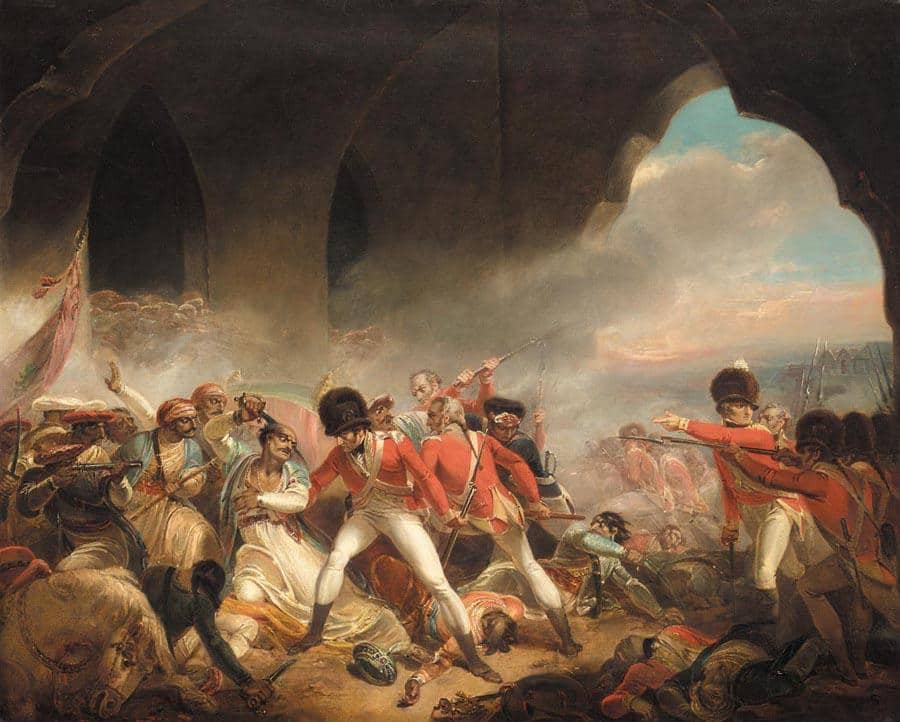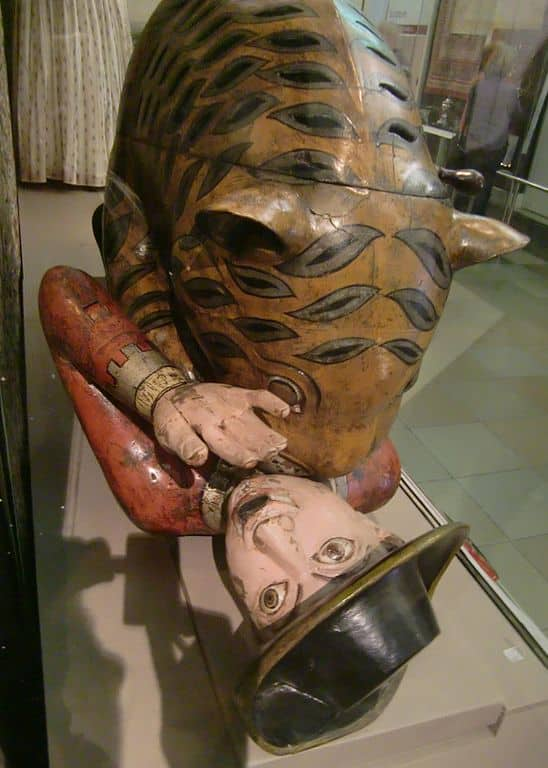



Tipu Sultan has always loomed larger than life, and if current debates are any indication, he will continue to do so. For the East India Company, his prowess and subsequent alliance with the French were sources of grave unease. There was much celebration in their ranks after the storming of so-called Seringapatam and his subsequent death.
The many eye-witness accounts and reports surrounding the events of May 4, 1799, are an enduring testament to the Tiger of Mysore’s significance. The sack of the imperial city also plays a pivotal role in what is considered a forerunner of the detective novel in English, Wilkie Collins’s The Moonstone.
 "The Last Effort and Fall of Tippoo Sultaun" by Henry Singleton (Image via Wikimedia Commons)
"The Last Effort and Fall of Tippoo Sultaun" by Henry Singleton (Image via Wikimedia Commons)One of the most remarkable artefacts from that time is the wooden automaton known as Tipu’s Tiger, once described by Keats as a “Man-Tiger-Organ, prettiest of his toys”. The almost life-sized representation of a tiger mauling a prostate European soldier is now displayed in the confines of London’s Victoria & Albert Museum. All these years later, it remains a potent symbol of the intensity of the conflict between an overseas trading company and a local king.
This mechanical tiger is at the heart of Loot, Tania James’s third novel, which is woven from the warp of historical facts and the weft of novelistic imagination. Loot: the English word is derived from the Sanskrit for plunder, and in James’s novel, the plunder is not just of treasure but also of potential.
The novel begins in Srirangapatna in 1794, where we meet the 17-year-old Abbas, a precocious woodworker. Abbas’s creations for the consorts of Tipu’s zenana have been appreciated, and he is summoned to the Summer Palace to help French inventor Lucien Du Leze with another fabrication.
This turns out to be “Mysore’s first automate”, as Tipu puts it. It is meant to be a gift for his sons, a work of “such grandeur and ferocity” that it will silence memories of their captivity at the hands of Lord Cornwallis. The tiger’s creation and afterlife reverberate throughout the rest of Loot.
Abbas is a quick study, and James briskly outlines his reactions to others in the palace as well as details of crafting the automaton under the supervision of Lucien Du Leze. The latter’s early sketch lays out the task. “The tiger will be hollow, with a bellows in the head and a pipe organ in the body. A lateral slice just above the tiger’s ears will create a sort of lid, which, when removed, will expose the organ pipes. A door along its rib cage will open onto a set of ivory keys, to be operated by an organ player poised by the tiger’s left flank.”
 Detail from Tipu's Tiger, now at V&A Museum in London. (Via Wikimedia Commons)
Detail from Tipu's Tiger, now at V&A Museum in London. (Via Wikimedia Commons)The Frenchman himself is memorably portrayed. Though outwardly confident, he is nevertheless wracked by uncertainty about when and how to return to France, given the aftermath of that country’s revolution.
The automated tiger is enthusiastically received, and Tipu proclaims that similar creations will, in future, do the work of craftspeople such as embroiderers and metalsmiths. By such means, he will elevate his kingdom through trade and industry, and it will remain unchallenged.
This dream, as we well know, was not to be. The dogs of war are unleashed upon the Tiger of Mysore, and Abbas, Du Leze and the rest of Tipu’s kingdom are, to varying degrees, caught up in the siege of the city and subsequent depredations by the British.
 Tipu Sultan (Image via Wikimedia Commons)
Tipu Sultan (Image via Wikimedia Commons)The action of the novel now shifts to the years that follow. Scenes are set on an English ship sailing from Pondicherry to France; in the French town of Rouen; and, finally, at Cloverpoint Castle in Twickenham. This Gothic mansion is where Tipu’s Tiger has come to rest for the moment.
More characters are introduced and fleshed out in these sections. In particular, there is the young Jehanne, daughter of a French engineer and Mysore noblewoman; and the 72-year-old Lady Selwyn of Cloverpoint Castle, with her Dickensian eccentricities, “a dreamy type, easily taken in by auras and imaginings”. The action pivots on attempts to regain possession of the mechanical tiger, with implicit and explicit questions about the nature of colonial ownership, artisanship, and recognition.
The novel encompasses tonal shifts too, from the intensity of the battlefield to elements bordering on farce, especially during Lady Selwyn’s riding expeditions and her games with Jehanne. A mid-novel feint of including a sailor’s diary entries is both unexpected and effective.
Unusually for a historical novel that covers a sweep of years and handles many characters, Loot is compact and moves swiftly from scene to scene. The pace is skilfully handled, and James’s prose stays crisp, crafted, and in control.
In a short verse, the contemporary British poet Daljit Nagra used Tipu’s Tiger as a symbol of defiance against imperial ways, especially the English language. In contrast, Tania James’s novel mimics the action of the automated tiger itself: it is an ingeniously constructed model of many parts that ventriloquizes attitudes from another time and makes them resonant again.
Discover the latest Business News, Sensex, and Nifty updates. Obtain Personal Finance insights, tax queries, and expert opinions on Moneycontrol or download the Moneycontrol App to stay updated!
Find the best of Al News in one place, specially curated for you every weekend.
Stay on top of the latest tech trends and biggest startup news.